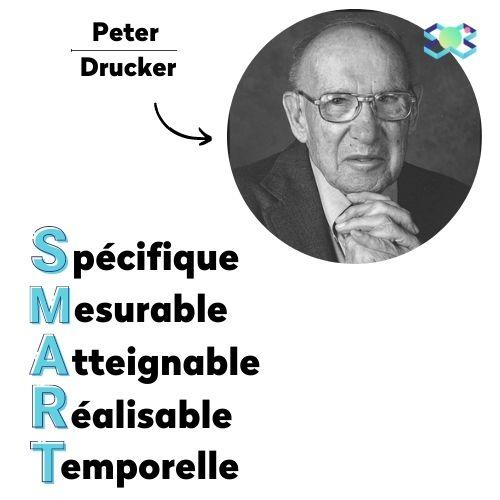The SMART method is an innovative method to push the productivity of your teams further 💪
This methodology offers clear, motivating and engaging indicators. It is essential to take the customer relationship to another level and promote the productivity of your teams.
The SMART method helps you implement a management and project management methodology by setting achievable goals.
In this article, we explain the origin and definition of the SMART method:
The SMART method in outline

Setting objectives is a prerequisite for giving your teams clear guidelines on your ambitions and allowing them to be fully involved in their achievement.
However, setting clear and motivating objectives is a science that requires a good application methodology or you will not succeed in mobilizing your employees 😇
The definition of the SMART method: an application method that helps you define clear and intelligent objectives.
Invented in the 1980s by the American economist Georges T. Dorant, it takes up the management concepts of Peter Drucker‘s objectives. Among other things, it offers managers the opportunity to optimize the results of their employees to guarantee the success of a project.
The SMART method in French can also be found under the name ASMAC. It is made up of 5 indicators which must characterize the objectives defined in this framework: specific, measurable, achievable, realistic and time-bound.
The method is suitable for several types of projects, particularly in the field of marketing, human resources, project management and management.
Many examples of SMART methods can be found and applied. Now let’s see how goal setting is done with the SMART methodology.
How to set SMART goals
At the start of the SMART method, there is therefore an economist and a business management consultant. These 2 actors together theorize a method of defining objectives which must be both qualitative and quantitative to be achieved over a given period 👏
The objectives must meet five indicators of success: they must be specific, measurable, achievable, realistic and time-bound.
a) Specific objectives
S for Specific!
When imprecise or inconsistent goals are imposed, they may seem unjustified and meaningless.
This obviously plays on our motivation to achieve them, since we don’t know what will be achieved once the objective has been validated ✅
To motivate your employees, nothing is more important than giving specific objectives. This amounts to quantifying what is quantifiable. For example, the increase in sales you want to achieve.
This allows your employees to identify with a team dynamic and a brand identity that boosts them and gives them the necessary motivation to improve their daily actions.
b) Measurable objectives
M for Measurable!
To be attainable and quantifiable, the goals you set must be measurable.
It is difficult to know if an objective has been achieved:
- when we cannot have clear data that allows us to know where we should go
- if we get close to our goal
This also allows each of your employees to identify, once again, with a team dynamic.
The figures presented in a clear manner are transparent to everyone: interpretation is not possible. Also, you are certain that everyone is working from the same perspective, without bias in understanding.
The concrete objective translated by numerical data is more easily communicated, and therefore, more easily achievable ❣️
c) Achievable goals
A for attainable!
To grow serenely, your team and your company must be anchored in the reality of their activity and the market in which they operate. It is therefore a question of being ambitious, but realistic 🌈
Thanks to the SMART method at work, you learn to set up attainable objectives for your collaborators, which will function as steps leading to ever more important objectives.
Ask yourself the right questions :
- Do the objectives set require means, time, skills that I do not have ?
- Are they in line with the sector in which my team operates?
It is by considering things with realism that you will be able to give your employees the means of your ambition.

d) Realistic goals
R for Achievable!
The objectives set must therefore be realistic:
- Achievable requires being judicious, and strategist
- Realistic requires being relevant
The relevance of the objectives you set for your employees will increase their motivation, which is an essential resource 🤩
To positively evolve your team and take it with you to the next level, set profitable goals.
If a goal is relevant and profitable, it does not waste the precious resources you have that can be used for other purposes.
e) Time-bound objectives
T for Temporal!
Here, it is a question of defining objectives that are defined in time ⏰
Indicate a deadline to your collaborators, for example by fixing regular assessments, interviews.
If the goal review takes the form of a meeting your team attends, be sure to send them an agenda.
This will let them know in advance what goals you want to discuss. This will influence the individual and collective organization of your employees and promote productivity.
************
The SMART method responds to a need in project management and methodology that requires being relevant.
At the crossroads of project techniques and behavioral sciences, it allows any business leader, manager or project manager to mobilize their employees effectively and clearly, while respecting their work.
Defining clear objectives for each member of the team allows for more fluid communication and easy measurement of the achievement of a long-term goal.
Your strategy is optimized and your resources saved. In addition, an efficient and fair distribution of tasks allows everyone to feel valued and recognized in their work.
************
Do you want to know more about the SMART method? Contact us to discuss











